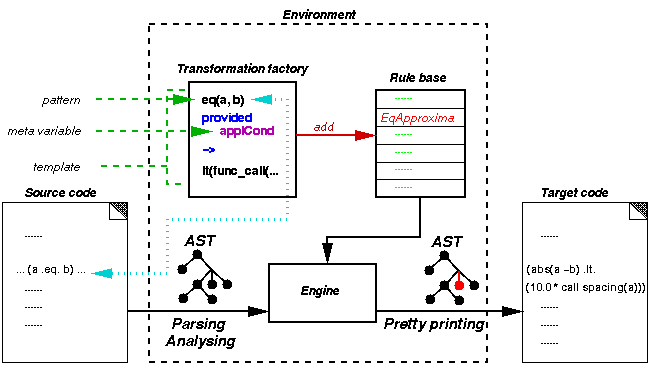TrfL scope and applications
Our aims, with the TrfL language is twofold: 1) promote the expressiveness of the language, with a powerful pattern-matching mechanism with access to contextual information and 2) give an interactive environment to build or modify transformations by clicking for both users and experts (in programming transformations). TrfL is a generic rule-based Transformation Language. TrfL is generic, it is not dedicated to one language but we focus on the advantage of using this language in an FORTRAN environment. TrfL intends to be used by both FORTRAN programmers and experts (who know TrfL, AST, FORTRAN, ...). A user can specify simple transformations with few effort, transformations like adding/removing a parameter in function definitions/calls, tests on array indexes don't require a great level of knowledge. More complex transformations like moving from a programming convention to another one, from FORTRAN77 to FORTRAN90, ... have to be specified by an expert. A TrfL specification is a set of transformations rules. Roughly, a transformation consists (Fig. 1) of a source pattern, a target pattern and an application condition. A source or target pattern is an abstract syntax tree (AST) with meta-variables (place holders that represent arbitrary pieces of source code). An abstract syntax tree is a structured representation of a program that omit all unnecessary information like keywords. The application condition is a predicate that must be true in order for the rule to be fired. The target pattern is a replacement for the source code when the source pattern has matched the source code, the meta-variables have been instantiated and the application condition is verified. The patterns represent the syntactic part of the rule and the application condition can refer to non local and semantic informations (symbol table, control flow graph,...) in order to restrict to applicability of the rule. Compared to others transformation languages which generally allow very restricted form of pattern matching, TrfL enhances this mechanism. In these transformation languages, a pattern can only match near the root of a tree term or it can only select fixed number of items in list tree. TrfL patterns offer more than only abstract syntax tree with meta-variables, patterns can match at arbitrary distance from the root of the whole term and anywhere in list tree. The user only describe the shape of the subtree he wants to match, and not where and how such a subtree should be found. Thus it becomes easier to describe a pattern that find nested loops for example. Others features of the language are transformation composition (combine several transformations to make one), if, case structures and post actions (that can be used to update contextual information, or to emit a warning message to the user for example).
Figure 1: A sample transformation
The TrfL system (Fig. 2) consists of an engine and of an environment. The engine takes a source program, searches for pieces of code that match a transformation, checks the application condition of that rule to validate its applicability. If the condition is valid, the selected code is replaced with the instantiated target pattern. If the condition is not valid, the current transformation rule is not used and the engine continues its job (find a new transformation rule for the same piece of code, look for a new piece of code,..). The engine has several decisions to make during the transformation process:
- How the source code should be searched?
- Which rule should be fired if more than one is applicable?
- Should rules be reapplied?
- ...
The environment supports two functions:
-
it embeds the engine. One may want to perform the transformation process in batch mode without interaction, in this case some parameters (to control the points listed above) must be set before running the process and the engine can work stand alone. In another way the user can interact on the process, 1) by guiding or controlling the engine, 2) by choosing a piece of code and then the engine gives the list of valid transformations, 3) by choosing a transformation and then the engine shows where this transformation can be applied.
-
it provides a framework to build or modify transformations. Patterns are abstract syntax trees, but a user is more familiar with the concrete syntax than with the abstract syntax and then building transformations could be a hard task. This can be solved with an interactive building of a transformation from a template code and pattern from a source code, by selecting on the piece of code that ``looks like'' the desired pattern and then by refining it with meta-variables. A template is a transformation rule with holes (in fact meta-variables) that the user fills in selecting trees or predefined constructs.

Figure 2: The transformation system